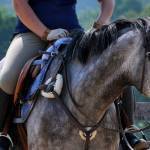Health Considerations for Retired Racehorses

With their innate athleticism and intelligence, retired Thoroughbred racehorses often prove valuable as pleasure and competition horses, finding steady employment in many disciplines. These horses are often placed in new homes through trainer or owner connections and adoption organizations. If horses have passed through several owners, their health history may be incomplete, leading to questions about their future potential.
To better understand the well-being of off-track Thoroughbreds, Australian researchers investigated the health issues of rehomed racehorses using data collected from 27 trainers.* In total, 110 horses were retired during the 13-month study period.
About half of all retirements were involuntary, and the most common reasons for involuntary retirement included musculoskeletal injuries, respiratory setbacks, cardiac conditions, and behavioral problems. Horses retired voluntarily by trainers, on the other hand, were usually described as having insufficient ability or having reached their athletic peak.
Researchers followed up on the horses 14 months after retirement. Nearly half found a second career as either a show or pleasure-riding horse. Horses voluntarily retired were more than two times as likely to continue a performance career, as opposed to being used for recreational riding or breeding.
“The fact that musculoskeletal injuries were the most common reason for retirement is not surprising, considering the wear and tear sustained by an athletic horse’s joints. This is why joint supplements are popular products in the racing industry,” said Kathleen Crandell, Ph.D., a Kentucky Equine Research nutritionist.
“Another condition that owners of retired racehorses should be aware of is stomach ulcers,” Crandell explained. Almost every Thoroughbred racehorse suffers some degree of gastric ulceration, according to published studies.
“Ulcers can resolve on their own after the stress of training has diminished and horses have access to pasture. The change in the environment together with increased liberty of movement, free-choice forages, and moving away from large, high-concentrate meals will allow for healing,” Crandell explained. “After being rehomed, retired racehorses should be examined by a veterinarian for gastric ulcers, preferably by gastroscopy, with an appropriate treatment prescribed, if necessary.”
Ulcers resolve slowly even with appropriate treatment and often recur, especially if the horse has been moved quickly into retraining.
“These horses can therefore benefit from a gastric protectant. High-quality products may contain fast-acting antacids and coating agents designed to quickly neutralize excessive gastric acid, protect the stomach lining, and restore the normal gastric environment,” Crandell recommended.
*Crawford, K.L., A. Finnane, R.M. Greer, C.J. Phillips, S.M. Woldeyohannes, N.R. Perkins, and B.J. Ahern. 2021. Appraising the welfare of Thoroughbred racehorses in training in Queensland, Australia: The incidence, risk factors and outcomes for horses after retirement from racing. Animals (Basel) 11(1):142.








